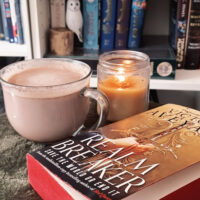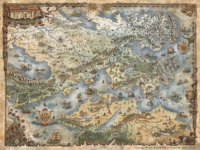
Are you, like me, a massive fan of Fantasy books, especially those with maps printed in the endpapers? Let’s go on an adventure through some of the awesome Fantasy worlds and realms of fiction!
Fantasy, as a genre, is a vast realm filled with near endless possibilities. Its diverse sub-genres can cater to almost every reader’s taste, while still retaining elements of magic and wonder. Whether you find yourself drawn to the grandiose adventures of High Fantasy, or the more grounded tales of Low Fantasy, there is something magical for everyone to discover. You may come across pseudo-Medieval settings with knights and dragons, or Urban landscapes where magic lurks in the shadows of skyscrapers. Or, perhaps you are drawn to the dichotomy between Dark Fantasy, with its eerie and mysterious elements, and Cozy Fantasy, that offers a sense of warmth and comfort. What makes fantasy so captivating is its ability to transcend boundaries and blend different sub-genres seamlessly, blurring the lines between classifications and inviting readers to explore uncharted territories of imagination. In the end, it is this fluidity and adaptability that keep the realm of fantasy forever enchanting and ever-evolving.
But regardless of genre, most fantasy stories have one thing in common: their worlds. Most fantasy tales sprinkle a dash of magic into their worlds, whisking you away to realms where the impossible for us is just another Tuesday for them. Today, we’ll be taking a look at Primary, Secondary, and Portal World Fantasy stories! These are the basic world types on which the fantasy genre is built.
One of the main characteristics of High or Epic fantasy are their “second worlds”, where authors create the entirety of the universe in which their characters reside. The term “secondary world” comes from an essay by J.R.R Tolkein, author of Lord of the Rings, titled “On Fairy-Stories”. Inside these second worlds, “what [the author] relates is “true”: it accords with the laws of that world. You therefore believe it, while you are, as it were, inside.” Authors like J.R.R. Tolkien crafted entire universes, where the fantastical rules of the world are so concrete and defined, they become believable despite their reality as fantasy. As you wander through these mystical lands, a part of you starts to believe in the enchanting creatures and wonders, even if your brain knows they’re as real as a unicorn in your backyard. That’s the magic of Fantasy – it tickles your curiosity, making you ponder if there’s a sprinkle of truth in these fantastic tales. That’s also why Fantasy is part of the “Speculative” genre. It makes you wonder if these things could be real, or maybe once were real a long time ago.
 One recent example of a high fantasy series with a “Second World” is Victoria Aveyard’s Realm Breaker. The Companions of the Realm must undergo a journey of epic proportions, so the world of Allward must be suitably complex and vast.
One recent example of a high fantasy series with a “Second World” is Victoria Aveyard’s Realm Breaker. The Companions of the Realm must undergo a journey of epic proportions, so the world of Allward must be suitably complex and vast.
While second world fantasy stories have worlds that are completely separate from our own, that does not mean they are not inspired by the landscapes, cultures, and history of the real world. Each of the Companions come from different corners of Allward, and their individual customs and understandings of the world shine through their characters.
According to Aveyard, each region of the Realm takes inspiration from real-world cultures. Corayne, although the daughter of a pirate, was raised in Calidon, which has roots in Celtic/Gaelic culture; Galland, home to Andry Trelland, is “based on the Holy Roman Empire”; and Valtik’s Jydi culture is Scandinavian inspired (vaveyard.tumblr.com).
 Even the map of Allward itself is based on a mirror image of the Mediterranean!
Even the map of Allward itself is based on a mirror image of the Mediterranean!
As a fun fact, the map of Allward was illustrated by artist and cartographer Francesca Baerald! She has done some amazing work on maps for other books, video games, Dungeons and Dragons modules, and other tabletop RPG’s!
Other examples of Second World Fantasy are:
However, Fantasy stories can also be set in our real world. You have two branching pathways real-world fantasy stories can take. A Primary World, where magic bleeds into reality, or a Portal World, where real-world characters are transported to a secondary magical world. Primary Fantasy is set in real life, fitting the magical puzzle pieces in place so that they seem to always have fit with our world and its history. You can have Contemporary Fantasy, set in the here-and-now of the 21st century, or historical fantasy, which adds a magical spin to historical times and places. The Legendborn Cycle by Tracy Deonn is a great example of a primary world set in a contemporary period. The trilogy is set at UNC–Chapel Hill (a very real place) that is home to a secret society where Arthurian myth and magic are real.
Other examples of Primary World Fantasy are:
Portal Fantasy, on the other hand, takes characters from our familiar world and thrusts them into an entirely new and fantastical realm. This genre often begins with an ordinary protagonist discovering a hidden doorway, a magical wardrobe, or even falling down a rabbit hole, catapulting them into a land filled with wonder, danger, and adventure. Like The Chronicles of Narnia or Lewis Carroll’s Wonderland books, the characters are transported from the ‘real world’ to another world of enchantment, magic, and fantastic adventures. A great example of a portal world are the four parallel Londons of V.E. Schwabe’s Shades of Magic series. The “Red” London of Arnes, where Kell was born, the ashen “White” London, the long-dead “Black” London, and Lila Bard’s “Grey” London, the historical-fiction adjacent to our real-world London. Kell can travel back and forth between the realms through blood-magic portals he creates, as each world is sealed off from one another to prevent magic from spreading. Lila, a normal girl from “grey London” gets pulled into Kell’s world of magic. Shades of Magic also has a YA graphic novel series set in the same universe, The Steel Prince, that has some awesome artwork. Check it out!
Other examples of Portal Fantasy are:
All three types of fantasy worlds: primary, secondary, and portal fantasies provide rich landscapes for storytelling, each offering unique opportunities for exploring themes of heroism, discovery, and the coexistence of the mundane and the magical. They invite readers to question the boundaries of reality and to dream of the extraordinary hidden within the ordinary. Whether through the subtle enchantments woven into our world or the grand adventures in a far-off realm, fantasy stories continue to captivate and inspire, reminding us that magic can be found anywhere—if we only know where to look.





